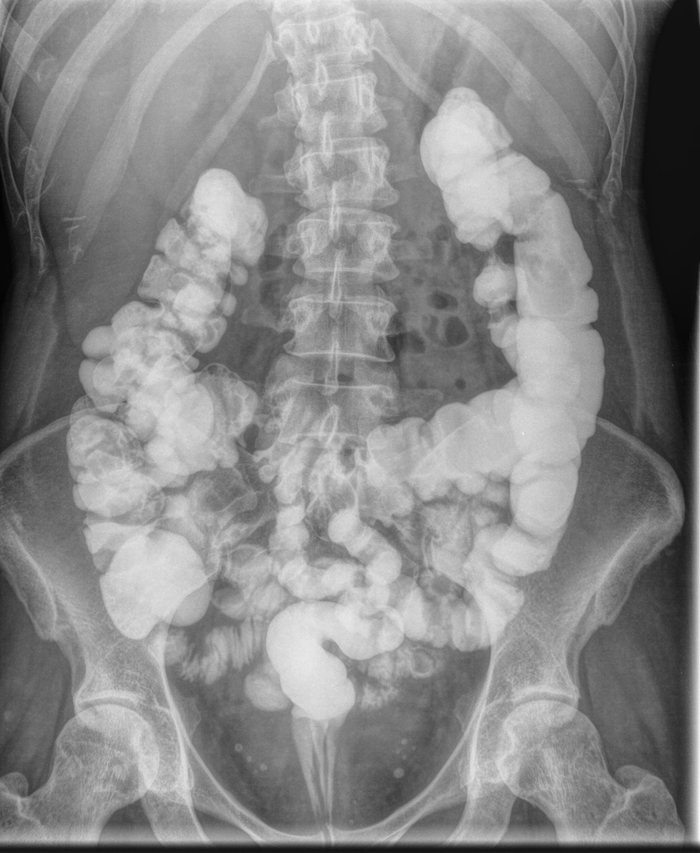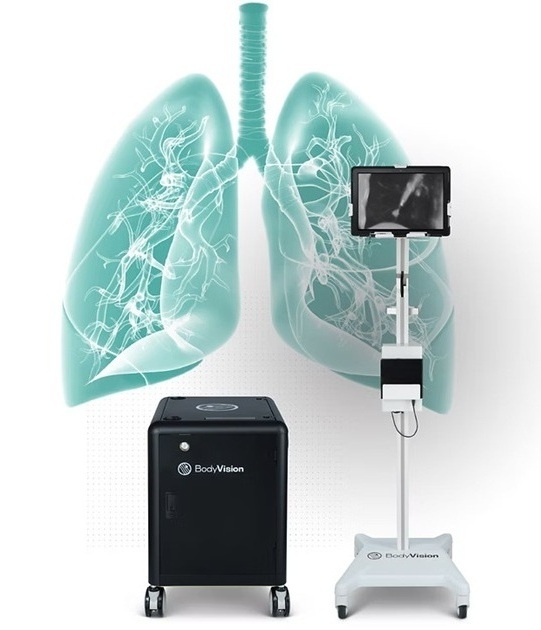Agfa HealthCare’s Next Generation of MUSICA Shows Significant Improvement in Projection Radiography Imaging
|
By MedImaging International staff writers Posted on 20 Mar 2014 |

Image: Next Generation MUSICA image (Photo courtesy of AGFA Healthcare).
Validation results of Agfa HealthCare’s (Mortsel, Belgium) MUSICA (Multi-Scale Image Contrast Amplification) next generation image processing software were made available at this year’s ECR meeting, accompanying the launch of the product in Europe.
Dirk Van Haute is Applications Specialist at Agfa HealthCare. He conducted the validation study of MUSICA among radiologists in Europe. The results showed a major preference for the next generation of MUSICA. “There’s no doubt about this, across different countries, centers and radiologists.”
With respect to the European arm of the validation, Mr. Van Haute asked 12 radiologists across Europe to view images from the Agfa HealthCare image bank, rate their preference between the previous and the next generation MUSICA software. The scale ran from -2 to +2, with -2 representing a strong preference for the previous version and +2 a strong preference for the new image processing.
For skeletal images, radiologists rated the new equipment highly at 1.5 on the -2 to +2 scale. Chest processing also showed a preference in favor of the next generation MUSICA with a score of +1.27; for abdominal image processing the reading was between slight and strong preference with an average score of 0.94. Overall, the validation showed that 80% of images evaluated are better or much better than the previous version. This is a significant improvement on the existing version of MUSICA.
Commenting on the skeletal findings, Mr. Van Haute said, “the diagnostic information was more accurate, radiologists comment that they can immediately see the information they require without the need for window leveling. Overall they have more confidence and the whole study is faster.”
Agfa HealthCare’s next generation of MUSICA was launched in Europe after being presented in the US at the Radiology Society of North America (RSNA) meeting in November last year.
John Gibbs is Global Product Manager Modality Workstations at Agfa HealthCare. He oversaw the European launch at this year’s ECR meeting. The next generation MUSICA image processing software is an integral part of Agfa HealthCare’s Computed Radiography (CR) and Direct Radiography (DR) equipment.
The technology processes raw images that arrive from the CR or DR modality before being sent to the PACS. The next generation of MUSICA has a range of advantages depending on which examination is being performed, Mr. Gibbs explained.
“For example, on a skeletal image, increased sharpness of the trabecular details is noticeable. With the next generation MUSICA image processing software, the overall homogeneity of the images is improved avoiding distracting bright areas in the images in for example cortical bone.”
Furthermore, Mr. Gibbs highlighted that consistency of image quality is evident across all applications from skeletal to abdomen to chest. “Our next generation of MUSICA is consistently in the top level of image quality which isn’t necessarily the case for competitor products which might be for imaging of one part of the anatomy and less so for others.”
Another advantage of the next generation MUSICA is its fully automated system of image processing. Other processors require tuning for specific exposure types for different parts of the anatomy and are more influenced by external factors like patient habitus and exposure technique.
Related Links:
Agfa HealthCare
Dirk Van Haute is Applications Specialist at Agfa HealthCare. He conducted the validation study of MUSICA among radiologists in Europe. The results showed a major preference for the next generation of MUSICA. “There’s no doubt about this, across different countries, centers and radiologists.”
With respect to the European arm of the validation, Mr. Van Haute asked 12 radiologists across Europe to view images from the Agfa HealthCare image bank, rate their preference between the previous and the next generation MUSICA software. The scale ran from -2 to +2, with -2 representing a strong preference for the previous version and +2 a strong preference for the new image processing.
For skeletal images, radiologists rated the new equipment highly at 1.5 on the -2 to +2 scale. Chest processing also showed a preference in favor of the next generation MUSICA with a score of +1.27; for abdominal image processing the reading was between slight and strong preference with an average score of 0.94. Overall, the validation showed that 80% of images evaluated are better or much better than the previous version. This is a significant improvement on the existing version of MUSICA.
Commenting on the skeletal findings, Mr. Van Haute said, “the diagnostic information was more accurate, radiologists comment that they can immediately see the information they require without the need for window leveling. Overall they have more confidence and the whole study is faster.”
Agfa HealthCare’s next generation of MUSICA was launched in Europe after being presented in the US at the Radiology Society of North America (RSNA) meeting in November last year.
John Gibbs is Global Product Manager Modality Workstations at Agfa HealthCare. He oversaw the European launch at this year’s ECR meeting. The next generation MUSICA image processing software is an integral part of Agfa HealthCare’s Computed Radiography (CR) and Direct Radiography (DR) equipment.
The technology processes raw images that arrive from the CR or DR modality before being sent to the PACS. The next generation of MUSICA has a range of advantages depending on which examination is being performed, Mr. Gibbs explained.
“For example, on a skeletal image, increased sharpness of the trabecular details is noticeable. With the next generation MUSICA image processing software, the overall homogeneity of the images is improved avoiding distracting bright areas in the images in for example cortical bone.”
Furthermore, Mr. Gibbs highlighted that consistency of image quality is evident across all applications from skeletal to abdomen to chest. “Our next generation of MUSICA is consistently in the top level of image quality which isn’t necessarily the case for competitor products which might be for imaging of one part of the anatomy and less so for others.”
Another advantage of the next generation MUSICA is its fully automated system of image processing. Other processors require tuning for specific exposure types for different parts of the anatomy and are more influenced by external factors like patient habitus and exposure technique.
Related Links:
Agfa HealthCare
Latest Imaging IT News
- New Google Cloud Medical Imaging Suite Makes Imaging Healthcare Data More Accessible
- Global AI in Medical Diagnostics Market to Be Driven by Demand for Image Recognition in Radiology
- AI-Based Mammography Triage Software Helps Dramatically Improve Interpretation Process
- Artificial Intelligence (AI) Program Accurately Predicts Lung Cancer Risk from CT Images
- Image Management Platform Streamlines Treatment Plans
- AI-Based Technology for Ultrasound Image Analysis Receives FDA Approval
- AI Technology for Detecting Breast Cancer Receives CE Mark Approval
- Digital Pathology Software Improves Workflow Efficiency
- Patient-Centric Portal Facilitates Direct Imaging Access
- New Workstation Supports Customer-Driven Imaging Workflow
Channels
Radiography
view channel
Machine Learning Algorithm Identifies Cardiovascular Risk from Routine Bone Density Scans
A new study published in the Journal of Bone and Mineral Research reveals that an automated machine learning program can predict the risk of cardiovascular events and falls or fractures by analyzing bone... Read more
AI Improves Early Detection of Interval Breast Cancers
Interval breast cancers, which occur between routine screenings, are easier to treat when detected earlier. Early detection can reduce the need for aggressive treatments and improve the chances of better outcomes.... Read more
World's Largest Class Single Crystal Diamond Radiation Detector Opens New Possibilities for Diagnostic Imaging
Diamonds possess ideal physical properties for radiation detection, such as exceptional thermal and chemical stability along with a quick response time. Made of carbon with an atomic number of six, diamonds... Read moreMRI
view channel
New MRI Technique Reveals Hidden Heart Issues
Traditional exercise stress tests conducted within an MRI machine require patients to lie flat, a position that artificially improves heart function by increasing stroke volume due to gravity-driven blood... Read more
Shorter MRI Exam Effectively Detects Cancer in Dense Breasts
Women with extremely dense breasts face a higher risk of missed breast cancer diagnoses, as dense glandular and fibrous tissue can obscure tumors on mammograms. While breast MRI is recommended for supplemental... Read moreUltrasound
view channel
New Incision-Free Technique Halts Growth of Debilitating Brain Lesions
Cerebral cavernous malformations (CCMs), also known as cavernomas, are abnormal clusters of blood vessels that can grow in the brain, spinal cord, or other parts of the body. While most cases remain asymptomatic,... Read more.jpeg)
AI-Powered Lung Ultrasound Outperforms Human Experts in Tuberculosis Diagnosis
Despite global declines in tuberculosis (TB) rates in previous years, the incidence of TB rose by 4.6% from 2020 to 2023. Early screening and rapid diagnosis are essential elements of the World Health... Read moreNuclear Medicine
view channel
New Imaging Approach Could Reduce Need for Biopsies to Monitor Prostate Cancer
Prostate cancer is the second leading cause of cancer-related death among men in the United States. However, the majority of older men diagnosed with prostate cancer have slow-growing, low-risk forms of... Read more
Novel Radiolabeled Antibody Improves Diagnosis and Treatment of Solid Tumors
Interleukin-13 receptor α-2 (IL13Rα2) is a cell surface receptor commonly found in solid tumors such as glioblastoma, melanoma, and breast cancer. It is minimally expressed in normal tissues, making it... Read moreGeneral/Advanced Imaging
view channel
First-Of-Its-Kind Wearable Device Offers Revolutionary Alternative to CT Scans
Currently, patients with conditions such as heart failure, pneumonia, or respiratory distress often require multiple imaging procedures that are intermittent, disruptive, and involve high levels of radiation.... Read more
AI-Based CT Scan Analysis Predicts Early-Stage Kidney Damage Due to Cancer Treatments
Radioligand therapy, a form of targeted nuclear medicine, has recently gained attention for its potential in treating specific types of tumors. However, one of the potential side effects of this therapy... Read moreIndustry News
view channel
GE HealthCare and NVIDIA Collaboration to Reimagine Diagnostic Imaging
GE HealthCare (Chicago, IL, USA) has entered into a collaboration with NVIDIA (Santa Clara, CA, USA), expanding the existing relationship between the two companies to focus on pioneering innovation in... Read more
Patient-Specific 3D-Printed Phantoms Transform CT Imaging
New research has highlighted how anatomically precise, patient-specific 3D-printed phantoms are proving to be scalable, cost-effective, and efficient tools in the development of new CT scan algorithms... Read more
Siemens and Sectra Collaborate on Enhancing Radiology Workflows
Siemens Healthineers (Forchheim, Germany) and Sectra (Linköping, Sweden) have entered into a collaboration aimed at enhancing radiologists' diagnostic capabilities and, in turn, improving patient care... Read more




 Guided Devices.jpg)















